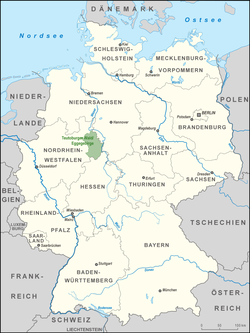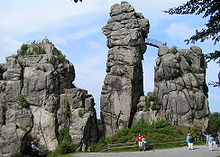Teutoburg Forest / Eggegebirge Nature Park
The Teutoburg Forest / Eggegebirge Nature Park is a nature park founded in 1965 in northeast North Rhine-Westphalia . After expanding the landscape in 2008, the nature park in the southern Teutoburg Forest and in the Eggegebirge with 2736 km² is the second largest in North Rhine-Westphalia and the sixth largest in Germany.
The Teutoburg Forest / Eggegebirge nature park and its “Naturally Healthy” concept together with the Rhineland Nature Park took first place in the state competition for the North Rhine-Westphalian nature parks “Naturpark.2009.NRW”. In 2015, a first place was won in the state competition of nature parks with the topic "Regional Products - Regional Identity".
geography

The northern area of the nature park begins directly southeast of Bielefeld and then stretches over the southern Teutoburg Forest in a south-easterly direction via Oerlinghausen and Detmold to Horn-Bad Meinberg . The southern area is directly connected to it and stretches over the Eggegebirge southwards via Bad Driburg and Willebadessen to almost Marsberg . In the east the nature park extends to the Weser near Höxter , in the west it extends to the city limits of Paderborn . The TERRA.vita nature park is located northwest of Bielefeld.
Besides the two eponymous foothills, parts are of the Weser mountain country , the Oberwälder Landeses and Lippe highlands and areas of karst landscape Paderborn Plateau and the Senne in the nature park. The highest point of the nature park is 495.8 m above sea level. NHN the Köterberg near Höxter, the second highest point is the Prussian Velmerstot at 468 m above sea level. NHN .
The regional climate has an average annual temperature of 7 to 8 ° C and annual precipitation between 625 mm (Warburg) and 1132 mm (Feldrom); it is considered a "gentle climate" with light to moderate climatic stimuli.
The region of the nature park is also known as "Germany's healing garden". The basis for this nickname is the Germany-wide unique density of natural remedies such as brine , moor and cold and warm healing waters . Spas such as Bad Salzuflen , Bad Lippspringe , Bad Meinberg and Bad Driburg as well as numerous climatic and Kneipp health resorts are located here on the edge of the Teutoburg Forest.
history
The "Lippe Nature Conservation Association" was founded as early as 1910. The aim was to designate the "Mittelgebirge nature reserve" with the Donoper pond as the core area, including the Lippe forest and the Lippe part of the Senne. A corresponding suggestion to the Principality of Lippe was made in 1911 by the “Verein Naturschutzpark e. V. "
The nature park, which was founded in 1965, is supported by a special-purpose association of the Lippe , Höxter , Paderborn , Gütersloh districts , the Hochsauerlandkreis and the independent city of Bielefeld. The association assembly comprises 22 representatives. The nature park is a member of the Association of German Nature Parks (VDN) and the North Rhine-Westphalian Nature Park Working Group.
The main task of the nature park is to link recreational provision and nature conservation . The focus here is on creating and securing landscape-related and nature-friendly recreational areas. For this purpose, the nature park has a well-developed network of hiking trails. In this way, the quiet low mountain range can be experienced while taking into account nature conservation and the value of adventure. At the same time, areas of cultural and historical interest such as castles, monasteries (e.g. Dalheim Monastery ), desert areas (e.g. Blankenrode urban desert ) or the visitor magnets Hermannsdenkmal and Externsteine are made accessible.
In 2008, the area was expanded to include the areas of the Höxter and Lippe districts that were not previously included. As a result, the area of the nature park more than doubled from 1059 km² to 2711 km².
natural reserve

About 30% of the area of the nature park is forested. As a large closed forest area, the landscape fulfills an ecological balancing function. The Egge Mountains and the Teutoburg Forest are therefore essential components of the state-wide biotope network . A good 67% of the area is protected as landscape protection areas , around 10.5% as nature reserves and around 11% as FFH areas . In addition, there are around 1000 registered natural monuments (e.g. trees, rocks, small biotopes). In 1974 the entire nature park, with the exception of a few nature reserves that had already been designated in 1974, was designated as a landscape protection area. Later, many areas were designated as other protected areas.
A mascot of the nature park is the European wildcat , whose regional occurrence is considered to be one of the original and still existing in North Rhine-Westphalia.
tourism
The nature park has a well-developed network of around 2000 km of marked hiking trails, which are equipped with around 120 hiking signs. There are also several themed adventure trails.
Since 2006 there have been around 70 trained, voluntary nature park guides who offer visitors a varied and qualified excursion program. The training and certification of the nature and landscape guides was conducted by the Nature and Environmental Protection Academy NRW (NUA). The aim is to familiarize children, young people and adults with the nature and landscape, culture and history of the Teutoburg Forest, the Senne and the Egge Mountains. As part of guided hikes, natural relationships are illustrated and information on local and cultural history is conveyed. The nature park guides have formed an association that works closely with the nature park.
In the Lippe district, many sights of the nature park are connected by the "nature park bus " ( KVG Lippe , tourist route 792) which, including a bicycle trailer, goes directly to the Detmold and Horn-Bad Meinberg train stations . The bus line runs every 60 minutes on weekends and public holidays from April to October.
Attractions
One of the largest underground carbon dioxide gas deposits in the world is located in the nature park in Stinkebrink near Bad Meinberg . The nature park has the greatest density of deserts in Central Europe. There are many monasteries and health resorts in the park.
- Externsteine
- Hermannsdenkmal
- Westphalian Galmeiveilchen in the Bleikuhlen Blankenrode
- Eggeweg and Hermannsweg
- Prussian and Lippian Velmerstot
- Köterberg
- Desenberg
- Altenbeken Viaduct
- Fürstenallee
- Rheder Castle near Brakel
- Heiligenkirchen Bird Park
- Adlerwarte Berlebeck
- Iburg near Bad Driburg
- Sparrenburg in Bielefeld
- Dalheim Monastery
- Hardehausen Monastery
- Corvey Monastery
- Westphalian Open Air Museum Detmold
- Princely residential palace in Detmold
- Archaeological Open Air Museum Oerlinghausen
- Weser Renaissance Museum in Brake Castle
- City desert Blankenrode
See also
literature
- Nature Conservation Center Senne (Ed.): Senne and Teutoburg Forest. tpk-Regionalverlag, Bielefeld 2008, ISBN 978-3-936359-32-9 .
- Willy Lippert: The Egge Mountains and its foreland. (Lippert hiking guide) Eggegebirgsverein. Bad Driburg. 1996. 5th ed.
- Sabine Schierholz: Guide to the Teutoburg Forest / Eggegebirge Nature Park. tpk-Regionalverlag, 2009, ISBN 978-3-936359-34-3 .
- World Habitat Society (Hrsg.): Freizeitkarte Naturpark Teutoburger Wald / Eggegebirge 1: 100,000. (Published for the Teutoburg Forest / Eggegebirge Nature Park), 2009, ISBN 978-3-9811646-1-9 .
- Hilmar Lotz: 20 years of the Eggebirge Nature Park and the southern Teutoburg Forest . In: Heimatland Lippe . Journal of the Lippe Heimatbund and the Landesverband Lippe. No. 10 . Detmold 1985, p. 326–334 ( digitized [accessed September 28, 2017]).
Web links
- Teutoburg Forest Nature Park
- Wolfgang Peters: Teutoburg Forest / Eggegebirge Nature Park. In: lwl.org. Landschaftsverband Westfalen-Lippe (LWL), accessed on September 28, 2017 .
swell
- ↑ a b What is a nature park? In: naturpark-teutoburgerwald.de. Accessed January 31, 2018 .
- ↑ Nature Park 2012, North Rhine-Westphalia. In: land.nrw. Retrieved September 28, 2017 .
- ↑ a b Figures, data & facts. In: naturpark-teutoburgerwald.de. Retrieved September 28, 2017 .
- ↑ Detmold district government: Natural stories. 100 years of state nature conservation in Ostwestfalen-Lippe ( memento from April 29, 2011 in the Internet Archive ), accessed on December 3, 2008.
- ^ Ordinance on the protection of parts of the landscape in the districts of Bielefeld, Büren, Detmold, Halle, Höxter, Lemgo, Paderborn, Warburg and the city of Bielefeld (nature reserve areas of the Eggegebirge and Teutoburg Forest) of November 27, 1972, Official Gazette for the Detmold district, 157 Issued in Detmold on December 4, 1972 No. 49
- ↑ The wild cat. In: naturpark-teutoburgerwald.de. Retrieved September 28, 2017 .
- ↑ Mobile nature park. In: naturpark-teutoburgerwald.de. Retrieved September 28, 2017 .
Coordinates: 51 ° 48 ′ 44 " N , 8 ° 52 ′ 1.2" E

